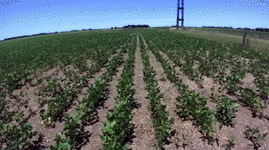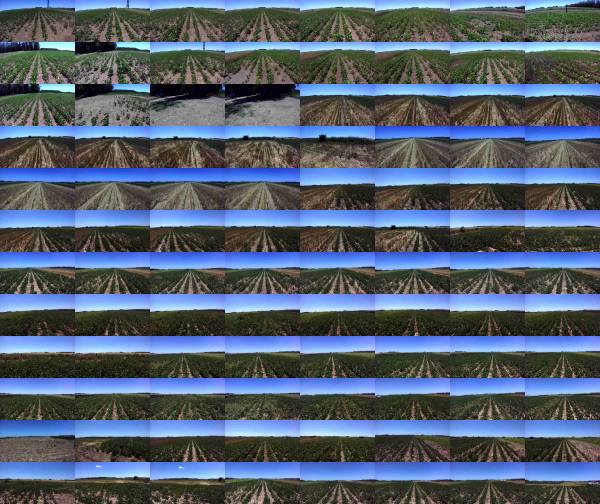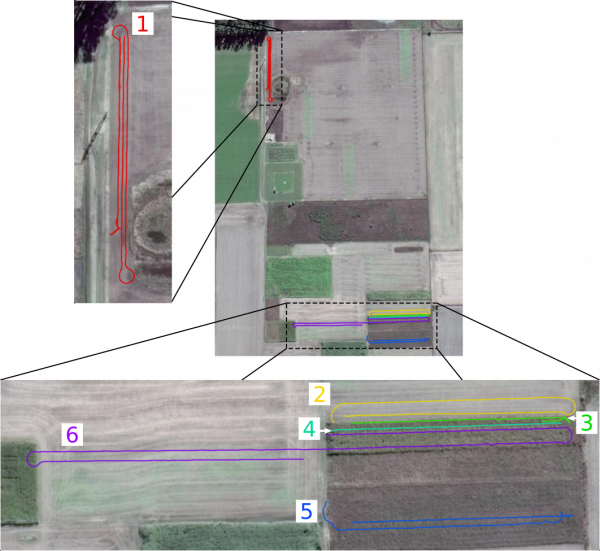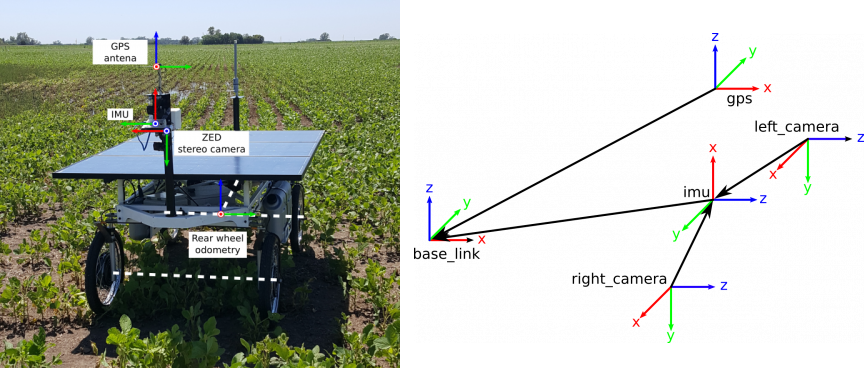Página principal
Sumario
The Rosario Dataset
This web page presents an agricultural dataset collected on-board out weed removing robot. The dataset is composed by six different sequences in a soybean field and it contains stereo images, IMU measurements, wheel odometry and GPS-RTK (position ground-truth).
If you use the Rosario Dataset in an academic work, please cite
Taihú Pire, Martín Mujica, Javier Civera and Ernesto Kofman. **The Rosario Dataset: Multisensor Data for Localization and Mapping in Agricultural Environments**. In: International Journal of Research Robotics, 2019. rosarioDataset2019.pdf
@article{pire2019rosario,
author = {Taih{\'u} Pire and Mart{\'i}n Mujica and Javier Civera and Ernesto Kofman},
title = {The Rosario dataset: Multisensor data for localization and mapping in agricultural environments},
journal = {The International Journal of Robotics Research},
volume = {38},
number = {6},
pages = {633-641},
year = {2019},
doi = {10.1177/0278364919841437}
}
Available Data
Stereo images (ZED Stereo Camera: colour images 672x376 @ 15 fps)
MEMS IMU (LSM6DS0 6-DoF Inertial Measurement Unit working at 140 Hz)
Wheel Odometry ( 3 x Hall effect sensors coupled to each rear wheel and 1 encoder attached to the robot direction)
GPS-RTK system (GPS-RTK modules working at 5 Hz)
Calibration (Intrinsic and extrinsic parameters)
Positional Ground-Truth (3D position Ground-truth computed from GPS-RTK)
Downloads
The dataset can be downloaded by torrent [coming soon] or by direct download using the provided links below. For direct download the aria2c command line from aria2c software is recommended:
aria2c -s 8 -x 8 <URL>
| Sequence 01 | |
|---|---|
| Rosbag | sequence01.bag.00 sequence01.bag.01 sequence01.bag.02 sequence01.bag.03 |
| Raw data | sequence01.tar.gz.00 sequence01.tar.gz.01 sequence01.tar.gz.02 sequence01.tar.gz.03 |
| Calibration | calibration01.yaml |
| Ground-Truth | sequence01_gt.txt |
| MD5 checksum (Rosbag) | 313c38109f9981b0c48e53e39be25b98 |
| MD5 checksum (Raw Data) | 667dbab7158540a403a0edc2c4aef5c3 |
| Sequence 02 | |
|---|---|
| Rosbag | sequence02.bag.00 sequence02.bag.01 |
| Raw data | sequence02.tar.gz.00 sequence02.tar.gz.01 |
| Calibration | calibration02.yaml |
| Ground-Truth | sequence02_gt.txt |
| MD5 checksum (Rosbag) | 753d9eb435a7fd6b8e40fad68672cac2 |
| MD5 checksum (Raw Data) | c01d280723471530ebede1763b04c0ea |
| Sequence 03 | |
|---|---|
| Rosbag | sequence03.bag |
| Raw data | sequence03.tar.gz] |
| Calibration | calibration03.yaml |
| Ground-Truth | sequence03_gt.txt |
| MD5 checksum (Rosbag) | b5659a491932910617a96b88405074a3 |
| MD5 checksum (Raw Data) | 25c53f826cc1db165965db03daff53d4 |
| Sequence 04 | |
|---|---|
| Rosbag | sequence04.bag |
| Raw data | sequence04.tar.gz |
| Calibration | calibration04.yaml |
| Ground-Truth | sequence04_gt.txt |
| MD5 checksum (Rosbag) | 887ad3b3173356c03ab02ae9ad27cc8d |
| MD5 checksum (Raw Data) | e9a9d6fbcad3fe77785454058fe6bb65 |
| Sequence 05 | |
|---|---|
| Rosbag | sequence05.bag.00 sequence05.bag.01 |
| Raw data | sequence05.tar.gz.00 sequence05.tar.gz.01 |
| Calibration | calibration05.yaml |
| Ground-Truth | sequence05_gt.txt |
| MD5 checksum (Rosbag) | a4e61b22c9ac0b818ceff9e23ea6d076 |
| MD5 checksum (Raw Data) | df7c6201762916d56520c17299eb03c0 |
| Sequence 06 | |
|---|---|
| Rosbag | sequence06.bag.00 sequence06.bag.01 |
| Raw data | sequence06.tar.gz.00 sequence06.tar.gz.01 sequence06.tar.gz.02 sequence06.tar.gz.03 |
| Calibration | calibration06.yaml |
| Ground-Truth | sequence06_gt.txt |
| MD5 checksum (Rosbag) | e149bd1bec465c446d1d1c050fc003b4 |
| MD5 checksum (Raw Data) | 6c70ceacf717568947c92b592a037115 |
Dataset join and decompress
Some sequences were compressed and split in order to facilitate their download. To join the different parts the following command should be used:
cat sequenceXX.bag.* > sequenceXX.bag
rosbag decompress sequenceXX.bag
cat sequenceXX.tar.gz.* > sequenceXX.tar.gz
tar xvzf sequenceXX.tar.gz
- Note: ** To check if the data is not corrupted you can use the MD5 checksum numbers. Observe that provided checksum numbers for .bag files correspond to the compressed rosbags.
Raw data format
The raw data format is detailed in raw_data_format.
Dataset parsers
A simple dataset parser is available here: https://github.com/CIFASIS/dataset-processing.
To create a rosbag from the raw data use:
python create_bagfile.py --images <sequence04/zed/> --imu <sequence04/imu.log> --gps <sequence04/gps.log> --calibration <calibration04.yaml> --odom <sequence04/odometry_raw.log> --out sequence4.bag
Note: Consider using compressAndSplit.sh directly to avoid previous issues with data.
Platform and Sensors
The weed robot was used for the dataset collection (see Figure 3). The weed removing robot was supported by the //Development of a weed remotion mobile robot// project at CIFASIS (CONICET-UNR). The sensors coordinate systems and the relations among them are depicted too. All the sensors are synchronised by software.
IMU parameters
The parameters that we obtained for our IMU are the following:
| Sensor | White Noise | Bias Sigma |
|---|---|---|
| accel | 0.0006367367080238862 | 0.0002643259445927608 |
| gyro | 0.00028579943407611055 | 0.00007544790215216806 |
They should be used with caution, considering that it is a low-cost IMU. Increasing them 10 times (or even more) may be appropriate.
Ground-Truth and Evaluation
We provide a 3D position ground-truth computed from the GPS-RTK system (no orientation is provided). The GPS-RTK system is composed by two [GPS-RTK Reach] modules (one module is mounted on the rover and the other one mounted on the base station). We assessed the accuracy and performance of the GPS-RTK system in Pistarelli_et_al_2017 (spanish).
As there is no magnetometer mounted on the robot, it is not possible to know precisely the robot orientation in GPS UTM coordinate frame. To mitigate this issue, we propose to use the [[1]] library for SLAM algorithms evaluation.
In particular, the following command should be used to compute the Absolute Pose Error (APE):
evo_ape tum sequenceXX_gt.txt slam_tum_XX.txt -p --verbose --align
Known issues
- Odometry messages, obtained from encoders in wheels and direction, are not necessarily correct when the robot is externaly moved, i.e. pushed by hands. This does not affect neither Visual nor Visual-Inertial Odometry Systems but it would definitely have a negative impact if this information is taken into account. If the dataset is used for SLAM systems that consider wheel odometry, we suggest to avoid parts where the robot is moved backward.
Changelog
The dataset changes are depicted in CHANGELOG.
License
All data in the Rosario Dataset is licensed under a [Commons 4.0 Attribution License (CC BY 4.0)] and the accompanying source code is licensed under a [License].



